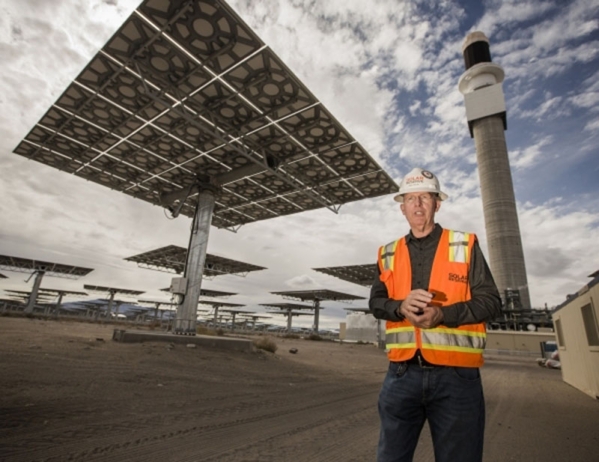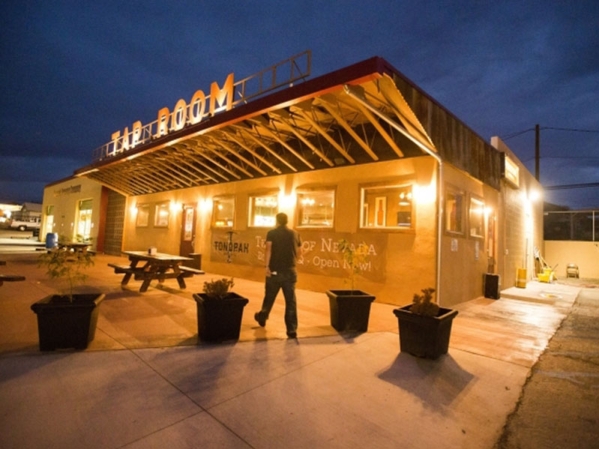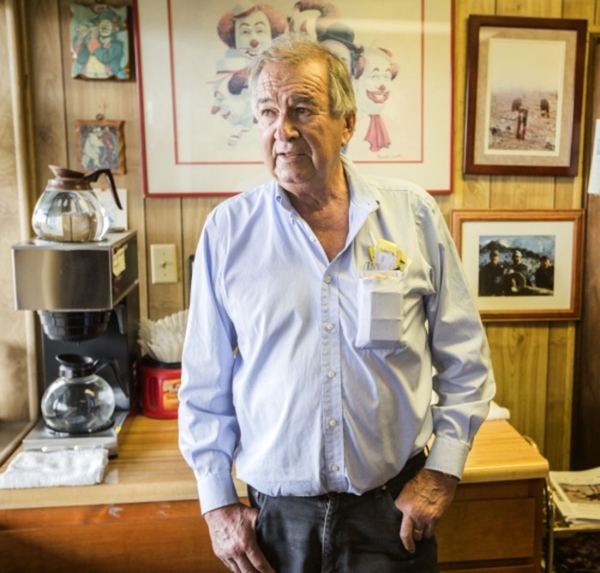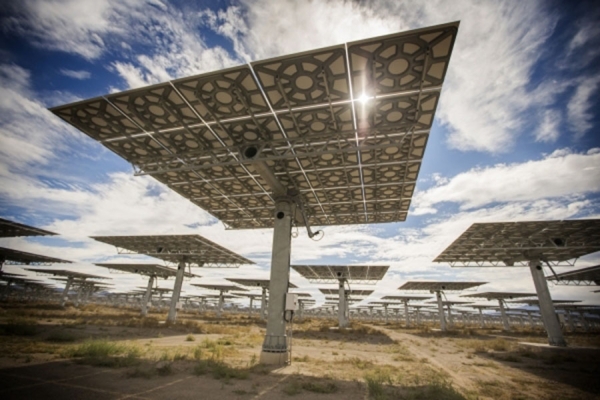Solar plant shines at the end of Tonopah’s tunnel
TONOPAH — After four years and almost $1 billion, the Crescent Dunes Solar Energy Plant 174 miles north of Pahrump delivered its first megawatts to the grid during a test run on Oct. 11.
And when it finally happened, it happened at night.
Site manager Brian Painter said he was so relieved and elated to see the plant sending out electricity that the real significance of the moment didn't dawn on him until the next day: energy from the sun producing power in the dark.
That ability to store what the sun provides and for later use is what sets Crescent Dunes apart from all other utility-scale solar energy projects. It also helps explain what's taking so long.
As Painter put it: "This is serial number 001. It's the only one in the world."
Apparently innovation on this scale takes time.
In February 2012, five months after ground was broken at the 1,600-acre site, officials for Santa Monica, California-based SolarReserve, owner of the project and its technology, said the plant should be operational by late 2013. But by January of this year, the 110-megawatt facility was still being tested. In March, officials said it wouldn't go online until the end of May.
The facility still isn't fully operational, but Painter said it is now in the final stages of startup. By early next year, he expects it to be delivering full power to NV Energy, which has agreed to buy the plant's entire load at 13.5 cents per kilowatt hour — roughly twice the cost of power from a natural-gas fueled plant — for 25 years.
"We're stepping through territory that's never been stepped through," Painter said. "We're just being very cautious of how we bring it online."
Meanwhile, outside pressure is mounting on the project, which was built on public land with the help of $737 million in federal loan guarantees.
Solar industry analysts and investors are waiting anxiously to see how the storage technology performs, especially because of disappointing early results from the 377-megawatt, $2.3 billion Ivanpah Solar Electric Generating System along Interstate 15 in California, just south of Primm.
Like Crescent Dunes, Ivanpah uses thousands of mirrors known as heliostats to focus the sun's energy on tall receiver towers. Unlike Crescent Dunes, Ivanpah can't store power for long periods and must burn natural gas to prime its boilers.
Painter said trouble elsewhere in the industry "certainly ups the ante" and puts his project "under a microscope more." But as far as he's concerned, there's nothing else out there that compares.
If Crescent Dunes performs the way SolarReserve believes it can, he said, "This one can change the game.
From silver to sunshine
As far as folks in nearby Tonopah are concerned, SolarReserve can take all the time it wants. Every additional day of construction means another day of economic benefit for the boom-and-bust town, which sprang up in 1900 around one of the largest silver strikes in Nevada history.
Already, Crescent Dunes ranks as Nye County's second-largest individual source of tax revenue. This year alone, the project is expected to contribute almost $3 million in property taxes to Nye's total budget of about $72 million, county records show.
"It's positively been a good thing for Tonopah," said Bob Perchetti, owner of the town's festive — and, some say, frightening — Clown Motel. "Solar's been nothing but good for the town."
At the peak of construction in 2013 and 2014, more than 1,000 people worked at Crescent Dunes. They also bought gas and groceries, ate in restaurants and rented apartments, hotel rooms and office space in the town of about 3,000 residents.
"Tonopah was bulging," Painter said.
Today the workforce is down to about 200. By next year, the finished plant will have a full-time staff of about 40.
But Perchetti said the town is still humming right along.
He ought to know. The 77-year-old was born in Tonopah, and so was his 95-year-old mother. When he stopped to chat about the town's fortunes, he was on his way to take her to dinner.
Perchetti said Tonopah hasn't seen a boom like this since the early 1980s, when Anaconda Minerals opened a new molybdenum mine 25 miles north of the Nye County seat.
At the time, the $250 million operation was considered the largest single private investment in Nevada history, but the operation shut down just two years later when the price of the commodity plummeted.
Perchetti expects the current upswing to have a longer life and a softer landing than that last one did. But even if it doesn't, Tonopah will live on, he said.
"It's always been a roller-coaster economy here. It's always been up and down.
Get small or go broke
The key to survival is knowing how and when to grow and shrink.
Before SolarReserve came to town, Carl Harris ran a family concrete business with a handful of trucks old enough to be in a museum.
Then he teamed up with Reno-based 3D Concrete to land what he called "the biggest job ever" — supplying Crescent Dunes with 130,000 cubic–yards of concrete.
Before long, the retired ironworker found himself with 28 employees, a fleet of 16 "pretty new" trucks and a concrete batch plant next door to his house.
During one six-week stretch in late 2011, that batch plant operated day and night to supply special ready-mix for Crescent Dunes' 640-foot central tower as it grew from the desert floor at a rate of about a foot an hour.
"It never stopped. It was just crazy," Harris said.
But even then, he knew the good times wouldn't last.
"I spent a lot of time in the pickup out on that solar job worrying about how we were going to get small, because that's where you'll go broke," he said.
The result is a Harris Concrete that's leaner and healthier than it was before Crescent Dunes, with newer equipment that should be ready for whatever comes next in Tonopah.
"The thing is don't get full of yourself and live high on the hog," Harris said.
Longtime developer and businessman Bruce Jabbour is hoping for a smooth transition of his own.
He runs Tonopah Hospitality Services, a collection of 22 military surplus housing units arrayed on a dirt lot next to the highway with room enough for about 150 people.
The business sprang up about two years ago specifically to provide weekly and monthly rentals to workers at Crescent Dunes. Some local residents still refer to it as the project's "man camp."
Every housing unit and every RV space on the property used to be filled with solar plant employees. Now they account for less than half of the total occupancy, though the property was still about 95 percent full on a recent Wednesday — a sign, Jabbour said, that "Tonopah is still on the move."
He believes Crescent Dunes will continue to have a positive impact on the community, both as an employer and a tourism draw.
Jabbour isn't kidding about that, either. He is convinced people will travel from other states and other countries just to see the finished solar array.
"It should be the next Hoover Dam attraction for Nevada," he said.
Mirrors and molten salt
Jabbour isn't the only one who thinks so, either.
SolarReserve is already outfitting Crescent Dunes with a visitor center, and the Bureau of Land Management has plans to put up an informational kiosk on the road in front of the plant.
Painter expects the first tourists to be energy developers and curious investors from around the globe.
"As far as solar goes, this is the center of our world," he said.
The plant is pretty hard to miss, especially when it's collecting sunlight. More than 10,000 mirrored heliostats, each with the square-footage of a small house, form a disc almost two miles across around a central tower the height of the Palazzo, Nevada's tallest completed building.
The mirrors follow the sun through the sky and focus its energy onto a receiver atop the tower, heating molten salt inside to more than 1,000 degrees.
After that, the facility behaves like any conventional power plant: The heat stored in the molten salt converts water to steam, and the steam drives generators to produce enough electricity for about 75,000 homes.
In this case, though, almost nothing is lost in the process. Both the salt and the water vapor are recaptured and used again, while the sun supplies all the juice. The only fossil fuel at the site is the stuff in the emergency generators and in the vehicles employees use to get to work.
Painter said all the synthetic salt the plant should ever need was shipped in from Germany last year in 33,000 1-ton bags. Then all 63 million purified pounds of it was poured into a propane furnace and cooked down to a liquid twice as dense as water and capable of storing up to 10 hours worth of energy.
Since then, the molten salt has been kept at a minimum of about 500 degrees to prevent it from reverting to a solid. It is circulated back and forth between two 3.6 million gallon tanks — one "hot" at around 1,000 solar-generated degrees, the other "cold" at about 550 degrees.
Several milestones have been reached at the plant in recent months. Painter and company found a way to stop killing birds with concentrated sunlight. Then they synced with the electrical grid. And then they delivered their first 50 megawatts to homes in Nevada, even after the sun had set.
"Making power in the dark, that was a big deal," Painter said.
All that's left to do is ramp the plant up to full capacity and open the spigot for NV Energy. Painter said he fully expects to be finished in Tonopah and on his way to his next big project a few months from now.
SolarReserve has announced plans to build another 100-megawatt solar plant with molten salt storage in South Africa. The second plant is expected to cost at least 30 percent less and take significantly less time to build than the first one did, according to a company spokeswoman.
If they can keep pushing the cost down with each successive project, Painter said this new technology should be able to compete in a shifting energy market presently awash in cheap natural gas and growing anxiety about human-caused climate change.
Standing at the edge of Crescent Dune's heliostat forest, he said he sees more than enough open land to fit 10 more solar plants just like it someday.
"We could supply a good chunk of Nevada's energy out of this valley," Painter said.
And there's a guy in Tonopah who would be happy to supply the concrete.
Contact Henry Brean at hbrean@reviewjournal.com. Find him on Twitter: @RefriedBrean



















